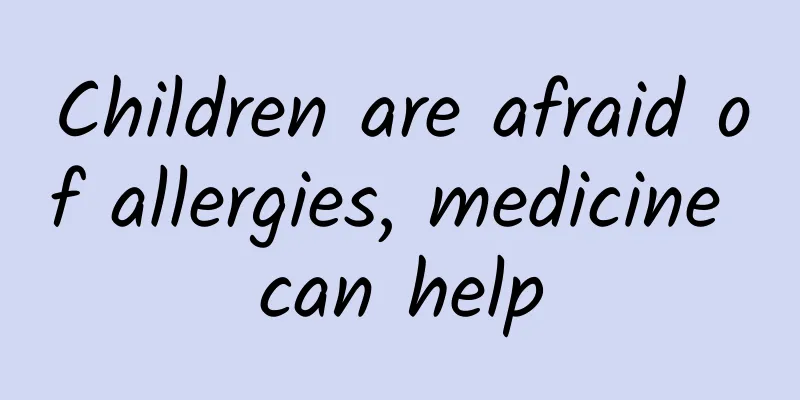Children are afraid of allergies, medicine can help

|
What are allergies? Spring is here, and it is a good time to go out for an outing. However, spring is also a high-incidence season for allergies. Babies with allergic constitutions are easily "infected" by pollen, dust mites and other substances in the air, causing skin redness, itching and other phenomena, affecting children's normal life. So what is allergy? Allergy is a type of disease caused by the body's immune system's hypersensitivity reaction to typical harmless substances in the environment. Infants and young children often suffer from food allergies and atopic dermatitis. Among them, our common allergic diseases include food allergies, atopic dermatitis, allergic rhinitis and allergic asthma. So what are the common anti-allergic drugs for allergic diseases, and what are the differences between them? Let me introduce them to you one by one. 1. Antihistamines Histamine is an important biogenic amine in the human body. When the human body is stimulated by allergens and an allergic reaction occurs, histamine is released. Antihistamines bind to histamine receptors H1 to prevent and treat allergic diseases caused by the release of histamine, and relieve symptoms such as nasal itching, runny nose, and tearing. They mainly play an anti-allergic role by antagonizing histamine. This type of drug is used in the vast majority of clinical cases. Currently, the commonly used antihistamine H1 receptor drugs are classified as follows: Oral antihistamines can be divided into: First-generation antihistamine H1 receptor drugs: As the "1.0 version" of traditional antihistamines, first-generation antihistamines are the first choice for the common cold. Common drugs include chlorpheniramine maleate, diphenhydramine, promethazine, cyproheptadine, ketotifen, etc. However, first-generation drugs have common adverse reactions such as sedation, drowsiness, decreased attention, and decreased cognitive learning ability due to their obvious central nervous system inhibitory effects; Second-generation antihistamine H1 receptor drugs: Common drugs include loratadine, cetirizine, etc. As the "2.0 version" of antihistamines, the biggest advantage is that the central inhibitory effect is significantly reduced, so the side effects are fewer than the first generation, but some drugs have adverse reactions such as cardiac toxicity and weight gain; second-generation oral antihistamines are the first-line drugs for the clinical treatment of allergic rhinitis in children, and can also be used for preventive medication for pollen allergies; New second-generation antihistamine H1 receptor drugs: upgraded versions of second-generation antihistamines, mainly including levocetirizine, desloratadine, etc. This type of drug is improved on the basis of the second generation, with the advantages of rapid onset, no cardiotoxicity, and fewer drug interactions. Common side effects include dizziness, dry mouth, etc., and adverse reactions can disappear after stopping the drug. In addition to oral antihistamines, we also commonly have some nasal anti-allergic drugs. Nasal antihistamine H1 receptor drugs: Clinically, nasal antihistamines mainly include azelastine hydrochloride nasal spray, levocabastine nasal spray, etc. Because of their strong local effects, they can relieve nasal symptoms such as sneezing and nasal itching after taking the medicine. They can be used on demand. Compared with oral medications, they have the advantages of being more convenient to use and faster onset. Their common adverse reactions are bitter taste in the mouth and irritation in the throat. 2. Leukotriene receptor antagonists : Common drugs such as montelukast sodium chewable tablets, etc., are suitable for the prevention and long-term treatment of asthma in children aged 2-14 years old, or to relieve symptoms caused by allergic rhinitis; 3. Allergic reaction mediator release inhibitors : This type of drug is also called mast cell stabilizer, which can stabilize mast cell membranes and prevent the release of histamine and other allergic reaction mediators. The main drugs include sodium cromoglycate, etc., which are often used to treat allergic rhinitis, bronchial asthma, allergic dermatitis and other diseases. The side effects of this type of drug are also prone to drowsiness and weight gain; 4. Hormone drugs: For example, common nasal corticosteroids, including mometasone furoate, fluticasone propionate, etc., are the first-line recommended drugs for the treatment of allergic rhinitis in children. They can relieve symptoms of allergic rhinitis such as nasal itching, nasal congestion, runny nose, etc., and can also relieve eye symptoms. So are there any special precautions when taking common anti-allergic drugs? 1. Children should pay attention to age limits when using antihistamines and use them according to the instructions. Common antihistamines in life include the following: ① Chlorpheniramine Maleate Tablets (Chlorpheniramine): Suitable for allergic dermatitis, urticaria, eczema, etc.; it should be noted that some compound anti-cold medicines also contain this ingredient (such as children's acetaminophen and chlorpheniramine, Ganmaoling granules, etc.). Parents should pay attention to whether they have used compound cold medicines. If they take chlorpheniramine maleate tablets again, it is repeated administration, which is easy to cause adverse reactions such as overdose. This medicine is suitable for children over 6 years old. It should be noted that children may experience drowsiness, dizziness, etc. after taking the medicine. ② Loratadine: Loratadine is commonly available in syrups and tablets. It is suitable for children over 2 years old and is used to relieve symptoms related to allergic rhinitis, chronic urticaria, itchy skin diseases, etc. ③ Cetirizine drops: Recommended for children over 1 year old, can be used to treat seasonal rhinitis, perennial allergic rhinitis and non-nasal conjunctivitis, etc. ④Levocetirizine dispersible tablets: can be used for seasonal allergic rhinitis, perennial allergic rhinitis, etc., suitable for children over 2 years old. When used, it can be dissolved in a small amount of water and then taken orally or swallowed directly. ⑤ Desloratadine dry suspension: It can be used to relieve the systemic and local symptoms of chronic idiopathic urticaria and perennial allergic rhinitis in children aged 6 months to 12 years. Dissolve an appropriate amount of this product in water before use and stir evenly before taking. 2. Montelukast sodium is also a common antiallergic drug in daily life, and it mainly has three dosage forms: ① Montelukast Sodium Tablets are suitable for the prevention and long-term treatment of asthma in patients over 15 years old, and to relieve the symptoms caused by allergic rhinitis; ② Different specifications of montelukast sodium chewable tablets are suitable for children of different age groups. The 5mg specification is suitable for children aged 6-14 years old; the 4mg specification is suitable for children aged 2-5 years old; ③ Montelukast Sodium Granules are suitable for children aged 1-5 years with asthma and allergic rhinitis. They can be taken directly or dissolved in infant formula or breast milk. They should not be dissolved in other liquids, but can be taken with an appropriate amount of water after taking the medicine. All of the above dosage forms can be taken once a day, one tablet (bag) at a time, before bedtime. Finally, if the child has a susceptible constitution, they should take protective measures on a daily basis to avoid contact with known allergens; take the children to do more physical exercises to strengthen their physical fitness and improve their immunity; in addition, parents should take their children to the hospital in time when they encounter allergies and other discomforts, and should not choose anti-allergic drugs for their children at will to avoid adverse drug reactions; you can consult a professional doctor or pharmacist for precautions on drug use during the medication period. References: [1] Zhu Hai. Correct selection of antiallergic drugs[J]. Jiangsu Health:, 2016. [2] Chinese Medical Association Allergy Branch Children's Allergy and Asthma Group, Chinese Medical Association Pediatric Branch Respiratory Group Asthma Collaborative Group. Expert consensus on the use of antihistamine H1 receptor drugs in common allergic diseases in children. Chinese Journal of Practical Pediatrics, 2018. [3] Li Chongni, Zhao Changqing, An Yunfang. Classification of histamine receptors and antihistamines and their application in allergic rhinitis[J]. Chinese Journal of Otorhinolaryngology and Skull Base Surgery, 2021, 27(4):6. (Lai Fangyuan, Shenzhen Children's Hospital) |
<<: Can I still take the medicine after opening it?
>>: Disease control warnings in many places: Norovirus is coming! How can we protect ourselves?
Recommend
Is it true that spraying vinegar on cabbage can repel insects? Is there any saying that spraying vinegar on cabbage can increase yield?
There is no doubt that cabbage can be sprayed wit...
Symptoms and pictures of female genital folliculitis
The symptoms of female genital folliculitis usual...
What is the cause of black blood clots in urine?
Some people may find black blood clots when urina...
Early clinical manifestations of vulvar leukoplakia
When you feel unwell, you cannot choose a treatme...
Luteinized ovarian cyst
Ovarian luteinized cysts, also known as ovarian l...
The boy was poisoned by a fish? Doctor: Every year, people eat fish...
Recently, in the ICU of the First Affiliated Hosp...
Can people who are allergic to penicillin, cephalosporin, or ofloxacin get the COVID-19 vaccine? Answer from Guangdong Centers for Disease Control
People's Daily Online, Beijing, June 25 (Zhan...
The harm of drinking probiotics for pregnant women
Probiotic powder is a substance that many people ...
What should women do if they have age spots?
We all know that when men reach middle age or old...
Common knowledge about dental cleaning
1. What is teeth cleaning? In the medical field, ...
How to solve the problem of lip hair for girls?
The image issue of women is very important becaus...
Symptoms of pelvic inflammatory disease, defeated by traditional Chinese medicine
Pelvic inflammatory disease is a relatively commo...
What should women eat during menstruation?
Everyone knows that every month, women will have ...
How to prevent pregnancy after childbirth
If you do not want a baby for the time being afte...
#千万IP创科普# How to prevent coronary heart disease? A few tips to tell you|Silver Age Science Popularization
Editor's Note Since last year, the Quanzhou S...









